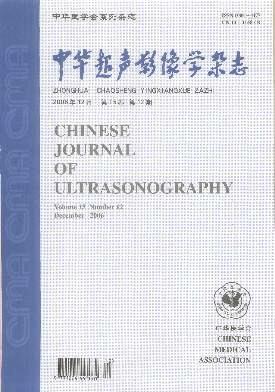Use of shear wave elastography in the evaluation of local advanced rectal cancer after neoadjuvant radiochemotherapy: the initial experience
Q4 Medicine
引用次数: 0
Abstract
Objective To investigate the value of shear wave elastography(SWE) to evaluate local advanced rectal cancer after neoadjuvant radiochemotherapy. Methods In a retrospective study, endorectal ultrasound(ERUS) and endorectal SWE were performed in 73 patients with local advanced rectal cancer before and after neoadjuvant radiochemotherapy. The mean and maximum values of Young′s modulus for SWE to evaluate the lesions before and after neoadjuvant radiochemotherapy were recorded. According to the postoperative pathological T stage, the lesions were divided into reduction of T stage group and non-reduction of T stage group. The efficacy of ERUS in diagnosing reduction of T stage was calculated, and the differences of the mean and maximum values of Young′s modulus between reduction of T stage group and non-reduction of T stage group was calculated, and the differences between the two groups were compared. ROC curves were constructed by the difference of mean and maximum Young′s modulus of lesions before and after neoadjuvant radiochemotherapy, respectively, to evaluate the diagnostic value of the difference in predicting reduction of T stage. Results A total of 57 cases had reduction of T stage after neoadjuvant radiochemotherapy (57/73, 78.1%). The mean and maximum values of Young′s modulus before and after neoadjuvant radiochemotherapy were compared, and the differences were statistically significant(all P<0.01). After neoadjuvant radiochemotherapy, the values of Young′s modulus of the lesions increased with the increase of pT stage. Compared with the mean values of Young′s modulus of the lesions in pT3 stage, the differences of the mean values of Young′s modulus of the lesions in pT0, pT1 and pT2 stages were statistically significant(all P<0.01). Compared with the maximum values of Young′s modulus of the lesions in pT3 stage, the differences of the maximum values of Young′s modulus of the lesions in pT0 and pT1 stage were statistically significant(all P<0.01). The differences of the mean value and the maximum value of Young′s modulus in the reduction of T stage group and the non-reduction of T stage group was statistically significant(all P<0.01). The ROC curve was established and determined by calculation. Taking the average difference of 34.7 kPa as the best diagnostic threshold, the average hardness of the lesion after neoadjuvant radiochemotherapy decreased more than 34.7 kPa to diagnose the reduction of T stage, the sensitivity, specificity and accuracy were 87.7%, 93.8% and 89.0%, respectively. Compared with ERUS, the difference was statistically significant(P=0.032). Conclusions Shear wave elastography is an effective technology to help ERUS in evaluating the lesions of rectal cancer after neoadjuvant radiochemotherapy and has a promising future. Key words: Endosonography; Rectal neoplasms; Elasticity imaging techniques; Shear wave elastography; Neoadjuvant radiochemotherapy剪切波弹性成像评价新辅助放化疗后局部晚期癌症的初步经验
目的探讨剪切波弹性成像(SWE)对癌症新辅助放化疗后局部晚期评价的价值。方法采用回顾性研究方法,对73例局部晚期癌症患者在新辅助放化疗前后行直肠内超声(ERUS)和直肠内SWE检查。记录新辅助放化疗前后SWE评估病变的杨氏模量的平均值和最大值。根据术后病理T分期,将病变分为T分期缩小组和T分期未缩小组。计算ERUS对T分期减少的诊断效果,计算T分期减少组和T分期未减少组的杨氏模量平均值和最大值的差异,并比较两组之间的差异。通过新辅助放化疗前后病变的平均杨氏模量和最大杨氏模量的差异,分别构建ROC曲线,以评估该差异对预测T分期降低的诊断价值。结果57例新辅助放化疗后T分期降低(57/73,78.1%),比较放化疗前后杨氏模量的平均值和最大值,差异有统计学意义(均P<0.01),病变的杨氏模量值随pT分期的增加而增加。与pT3期病变的杨氏模量平均值相比,pT0、pT1和pT2期病变的弹性模量平均值差异有统计学意义(均P<0.01),病变在pT0和pT1期的杨氏模量最大值差异有统计学意义(均P<0.01),T期缩小组和T期未缩小组的杨氏模量平均值和最大值差异均有统计学意义(均有P<0.01)。以平均差值34.7kPa为最佳诊断阈值,新辅助放化疗后病变的平均硬度下降34.7kPa以上,诊断T分期降低,其敏感性、特异性和准确性分别为87.7%、93.8%和89.0%。结论剪切波弹性成像技术是评价直肠癌症新辅助放化疗后病变的有效技术,具有良好的应用前景。关键词:腔内超声;直肠肿瘤;弹性成像技术;剪切波弹性成像;新辅助放化疗
本文章由计算机程序翻译,如有差异,请以英文原文为准。
求助全文
约1分钟内获得全文
求助全文
来源期刊

中华超声影像学杂志
Medicine-Radiology, Nuclear Medicine and Imaging
CiteScore
0.80
自引率
0.00%
发文量
9126
期刊介绍:
 求助内容:
求助内容: 应助结果提醒方式:
应助结果提醒方式:


